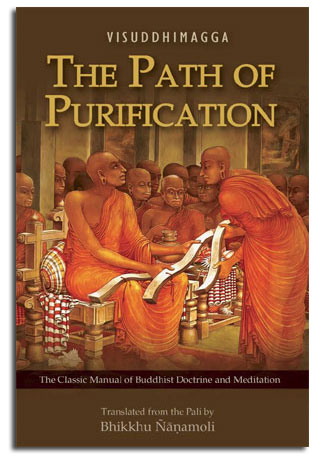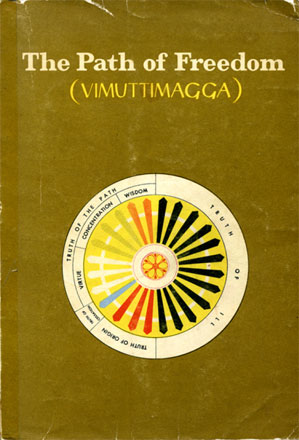The Visuddhimagga and Vimuttimagga in PDF / Free Download

©1975,1991,2011 Buddhist Publication Society
The Path of Purification / Visuddhimagga / Translated by Bhikkhu Nanamoli
2.7 MB in PDF / Free Download / Click Here
Publisher’s Note: The BPS thanks all those who assisted with making this book available in a digital as well as printed edition. This book is the result of the work of Mr John Bullitt of Access to Insight who initiated this digital edition, the several volunteers who helped him to convert the previous edition of this book to digital text, the other volunteers who helped the BPS with proofreading, Bhikkhu Nyanatusita, the BPS editor, who helped with and coordinated the proofreading, formatting, and typesetting, corrected the Pali, etc., and the work of the BPS typesetters Bhikkhu Sacramento Upatissa and Mr Nalin Ariyaratna who skilfully typeset the text.
"Buddhaghosa has composed one of the great spiritual classics of mankind. If I had to choose one book to take with me on a desert island, the Visuddhimagga would be my choice." Edward Conze.
Visuddhimagga or The Path of Purification, is a Theravada Buddhist commentary written by Buddhaghosa approximately in 430 CE in Sri Lanka. It is considered the most important Theravada text outside of the Tipitaka canon of scriptures. The Visuddhimagga is a systematic examination and condensation of Buddhist doctrine and meditation technique. The various teachings of the Buddha found throughout the Pali canon are organized in a clear, comprehensive path leading to the final goal of nibbana, the state of complete purification. Originally composed in the fifth century, this new translation provides English speakers insights into this foundational text. In the course of this treatise full and detailed instructions are given on 40 subjects of meditation aimed at concentration, an elaborate account of Buddhist Abhidhamma philosophy, and explicit descriptions of the stages of insight culminating in final liberation.
Bhadantacariya Buddhaghosa composed the Visuddhimagga in the early part of the fifth century. Bhikkhu Ñanamoli was ordained as a monk in Sri Lanka, where he spent 11 years living in a monastery and translating the texts of the Theravada Buddhism into English. He was the author of The Discourse on Right View, Middle Length Discourses of the Buddha, and The Life of the Buddha.
Visuddhimagga / Amazon.com Reviews of the Retail Version:
A marvelous translation of an indispensible text., By Will (Taos, NM United States)
This book is, indeed, "The Classic Manual of Buddhist Doctrine and Meditation". Written by Buddhaghosa in the Fifth Century in Sri Lanka, and known by its Pali title, Visuddhimagga, it is the fundamental manual for the Theravadin school of Buddhism, upon which the popular Vipassana meditation is based. But it is ever so much more than merely a Vipassana manual. Divided into three main sections covering the three "baskets" of Buddha's teaching, it first addresses Virtue (Sila) and a brief chapter on acceptable ascetic practices. Next there follows a large and wonderful section on training in Concentration (Samadhi) based on the forty traditional meditation subjects. Finally, it concludes with a large section on Understanding (Panna), the wisdom teachings of the Abhidhamma. If anyone has ever tried to learn and understand the Abhidhamma merely through study of the original texts (available in English through the Pali Text Society), then you will clearly appreciate the need for a commentary, and Buddhaghosa's commentary in the Visuddhimagga is one of the best. In general the book is comprehensive and profoundly helpful to one's practice, and to one's appreciation of the roots of Buddhist tradition as well.
This translation by Bhikkhu Nanamoli is wonderful. For years I had loved a translation by Pe Maung Tin, put out by the Pali Text Society. The language in that translation was more poetic, but I gradually grew to appreciate Bhikkhu Nanamoli's more approachable and practical language, and now I seldom refer to the other. There is for me, a Mahayana practitioner, something very beautiful and attractive in the bare, almost dry purity of Theravadin writings and practices, and this translation captures that quiet beauty very well. It is interesting to note that Bhikkhu Nanamoli, an Englishman who ordained in Sri Lanka at age 43 in 1949, and who then spent most of the rest of his remaining years in study and retreat, wrote this translation solely for his own use, because there were no available copies of the only other extant translation: only later did someone request him to publish it. We are fortunate that he did. I cannot recommend it highly enough to the serious practitioner or student.
One of the most famous books in Buddhist history., By steve (sunnyvale, CA USA)
This is it, the masterful commentary on Buddha's path that is one of the cornerstones of Theravada Buddhism. Although dense and difficult, the effort you put forth to understand this great beast of a book is well rewarded. Read the notes,stop after each paragraph and reflect, and you'll make you're way through. When you're finished, you'll be changed enough that you can go back to the beginning and get new insights on a second trip through.
Everyday, after I get off my meditation cushion, I chew my way though a few pages... It's good to be alive in a time when excellent English translations of this and other great Buddhist works are readily available.

The Path of Freedom / Vimuttimagga / Arahant Upatissa
18 MB in PDF / Free Download / Click Here
Vimuttimagga - Probably written in Pali in Sri Lanka during the first century AD, the Vimuttimagga survived only in Chinese translation, from which the present rendering has been made. Ascribed to the Arahant Upatissa, the work is a meditation manual similar to the Visuddhimagga, but less analytical and more practical in its treatment of meditation.
The work is compiled in accordance with classical Buddhist division of the path into the three stages of virtue, concentration, and wisdom, culminating in the goal of liberation. It is widely believed that the Vimuttimagga may have been the model used by Buddhaghosha to compose his magnum opus, the Visuddhimagga (Path of Purification), several centuries later. The older work is marked by a leaner style and a more lively sense of urgency stemming from its primarily practical orientation.